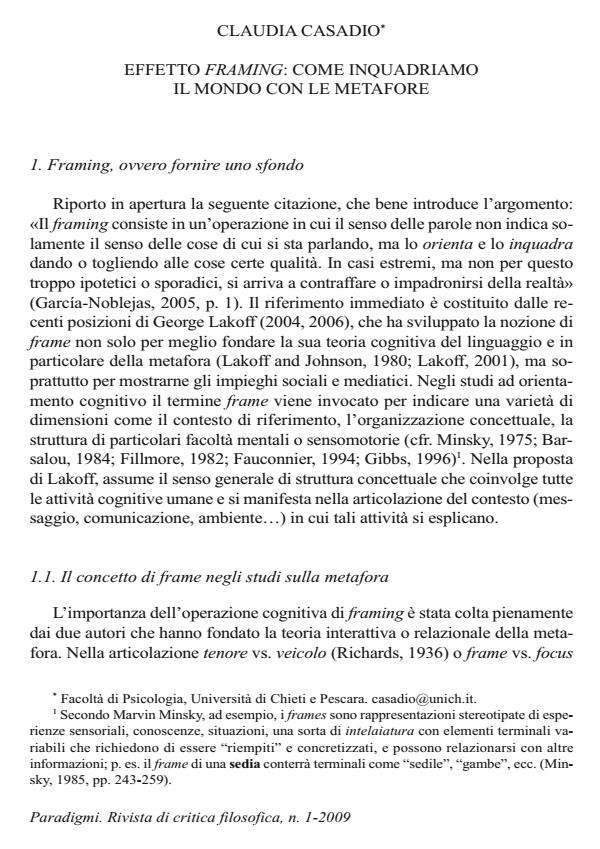Effetto framing: come inquadriamo il mondo con le metafore
Journal title PARADIGMI
Author/s Claudia Casadio
Publishing Year 2009 Issue 2009/1
Language Italian Pages 14 P. 55-68 File size 88 KB
DOI 10.3280/PARA2009-001005
DOI is like a bar code for intellectual property: to have more infomation
click here
Below, you can see the article first page
If you want to buy this article in PDF format, you can do it, following the instructions to buy download credits

FrancoAngeli is member of Publishers International Linking Association, Inc (PILA), a not-for-profit association which run the CrossRef service enabling links to and from online scholarly content.
Framing Effect. How Metaphors Frame the World - In the study of metaphor, frame is intended as the context, the environment, the landscape in which a metaphor is conceived, expressed and used; the term framing was introduced by George Lakoff within a cognitive setting and gives a distinctive shape to his theory. The idea however can be traced back to Richards (1936) and Black (1962): both the tenor vs. vehicle and the topic vs. focus distinctions, on the ba- sis of which they propose a general characterization of a metaphorical domain, can be considered as instances of framing in the sense argued by Lakoff. The same holds for recent cognitive theories of metaphor such as Way’s (1991) and Indurkhya (1992). Interestingly, the notion of frame has been invoked by well known psychologists like Kahneman and Tversky as a fundamental conceptual model for explaining human rational behaviour and decision making. In this paper we maintain that the psychological approach is not indifferent to the frame theory of metaphor. On the contrary, it offers useful clues and research hypotheses for further development. Keywords: Context, Decision, Focus, Frame, Metaphor, Rationality.
- Ignorant Cognition Selene Arfini, pp.115 (ISBN:978-3-030-14361-9)
- Ignorance-Preserving Mental Models Thought Experiments as Abductive Metaphors Selene Arfini, Claudia Casadio, Lorenzo Magnani, in Foundations of Science /2019 pp.391
DOI: 10.1007/s10699-018-9564-0 - Model-based abductive cognition: What thought experiments teach us Lorenzo Magnani, Selene Arfini, in Logic Journal of the IGPL jzae096/2024
DOI: 10.1093/jigpal/jzae096
Claudia Casadio, Effetto framing: come inquadriamo il mondo con le metafore in "PARADIGMI" 1/2009, pp 55-68, DOI: 10.3280/PARA2009-001005